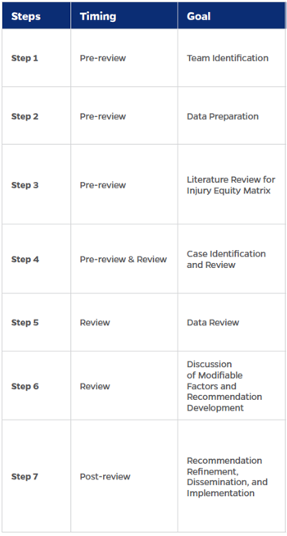Injury Prevention
Injury Prevention 1
137 - Massachusetts Pediatric Injury Equity Review: A New Process for Evaluating and Addressing Injury Inequities
Publication Number: 137.121
- SK
Sadiqa Kendi, MD, MPH (she/her/hers)
Associate Professor
Boston Medical Center
Boston, Massachusetts, United States
Presenting Author(s)
Background:
Injuries are the number one cause of death in children and young adults, and severe injuries lead to 6.3 million emergency department visits each year and a cost of over $25 billion annually for hospitalizations. While progress has been made in the implementation of many injury prevention strategies, racial disparities in pediatric injury deaths have persisted. The burden of mortality from unintentional injuries is disproportionately higher in people who live in rural settings, in those who are experiencing poverty, and in Black and American Indian/Alaskan Native youth. Much of the injury prevention community has focused on behavior change to address cultural differences as a significant factor contributing to injury disparities.
Objective: While behavior change is an important part of injury prevention on an individual level, we believe that racial disparities are caused by structural factors which can be systematically identified and modified. We designed the Massachusetts Pediatric Injury Equity Review (MassPIER) process to better identify and address these complex factors, and develop a process which can be utilized for various injury mechanisms and inequities.
Design/Methods: The Injury Equity Framework, which we developed over the past year, serves as the conceptual foundation for the Massachusetts Pediatric Injury Equity Review (MassPIER). We developed and optimized the Pediatric Injury Equity Review process in work done over the past year with three Massachusetts District Attorney Child Fatality Review teams, the Department of Public Health, the Johns Hopkins Center for Injury Research and Policy, and Boston Medical Center. We focused on fatal and non-fatal serious injuries, specifically using drowning and traffic injuries in our reviews over the past year. User satisfaction with the process was collected via focus group and REDCap survey.
Results:
We were able to develop and utilize a 7 step process to identify factors which contribute to inequities in injury, and recommendations to address those factors. Participants in the process rated it highly, with 81.8% strongly agreeing that the process was easy to follow and 70.5% strongly agreeing that the injury equity matrix utilized in the process facilitated equity-focused thinking and discussion around risk factors and possible recommendations.
Conclusion(s): This 7 step process is multidisciplinary, feasible, sustainable, and scalable. It is a new process which can be implemented to address injury inequities in other locales.
